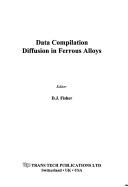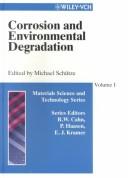| Listing 1 - 10 of 11 | << page >> |
Sort by
|

ISBN: 0871702304 Year: 1988 Volume: 1 Publisher: Calcutta Indian institute of metals
Abstract | Keywords | Export | Availability | Bookmark
 Loading...
Loading...Choose an application
- Reference Manager
- EndNote
- RefWorks (Direct export to RefWorks)
Iron alloys --- Phase diagrams, Ternary --- Ternary equilibrium diagrams --- Ternary phase diagrams --- Ferroalloys --- Ferrous alloys --- Alloys
Book
ISBN: 0080977669 0080977537 9780080977669 9780080977539 Year: 2013 Publisher: Oxford Elsevier Science
Abstract | Keywords | Export | Availability | Bookmark
 Loading...
Loading...Choose an application
- Reference Manager
- EndNote
- RefWorks (Direct export to RefWorks)
This handbook gathers, reviews and concisely presents the core principles and varied technology involved in processing ferroalloys. Background content in thermodynamics, kinetics, heat and mass transfer is accompanied by an overview of electrical furnaces theory and practice as well as sustainability issues. The work includes detailed coverage of the major technologies of ferrosilicon, ferronickel, ferromolybdenum, ferrotungsten, ferrovanadium, ferromanganese and lesser known minor ferroalloys. Distilling the results of many years' experience in ferroalloys, Michael Gasik has assembl
Alloys. --- Metals. --- Physical metallurgy. --- Iron alloys --- Mechanical Engineering --- Engineering & Applied Sciences --- Metallurgy & Mineralogy --- Iron alloys. --- Ferroalloys --- Ferrous alloys --- Alloys
Book
ISBN: 1845695453 1845693000 9781845695453 9781845693008 9781420079630 Year: 2009 Publisher: Cambridge, England
Abstract | Keywords | Export | Availability | Bookmark
 Loading...
Loading...Choose an application
- Reference Manager
- EndNote
- RefWorks (Direct export to RefWorks)
Weld cracks are unacceptable defects that can compromise the integrity of welded structures. Weld cracking can lead to structural failures which at best will require remedial action and at worst can lead to loss of life. Weld cracking in ferrous alloys reviews the latest developments in the design, evaluation, prevention and repair of weld cracks.Part one reviews the fundamentals as well as recent advances in the areas of welding technology, design and material selection for preventing weld cracking. Part two analyses weld crack behaviour, evaluation and repair of cracking/cracked weld
Welded joints --- Iron alloys --- Testing. --- Cracking. --- Ferroalloys --- Ferrous alloys --- Alloys --- Welding --- Cracking of welded joints --- Fracture mechanics --- Testing

ISBN: 3038130869 9783038130864 3908451329 9783908451327 Year: 2006 Publisher: Stafa-Zuerich
Abstract | Keywords | Export | Availability | Bookmark
 Loading...
Loading...Choose an application
- Reference Manager
- EndNote
- RefWorks (Direct export to RefWorks)
This issue comprises an extensive body of selected data, on diffusion in iron-based materials, gleaned from research published in leading journals during the past 70 years. The materials covered range from the almost-pure metal, to high-alloy steels (including metallic glasses) and the data reflect the effect of special conditions (thin films, strain, etc.) upon bulk, surface and pipe diffusion. This publication will constitute an invaluable first port-of-call for anyone looking for a quick guide as to the extent of diffusion which is to be expected to occur during any research project or indu
Diffusion. --- Iron alloys. --- Ferroalloys --- Ferrous alloys --- Alloys --- Gases --- Liquids --- Physics --- Separation (Technology) --- Solution (Chemistry) --- Solutions, Solid --- Matter --- Packed towers --- Semiconductor doping --- Diffusion --- Properties

ISBN: 0815510276 Year: 1985 Publisher: Park Ridge Noyes
Abstract | Keywords | Export | Availability | Bookmark
 Loading...
Loading...Choose an application
- Reference Manager
- EndNote
- RefWorks (Direct export to RefWorks)
Iron alloys --- -Iron alloys --- -Metals --- -Steel alloys --- -Alloys --- Metallic elements --- Chemical elements --- Ores --- Metallurgy --- Ferroalloys --- Ferrous alloys --- Alloys --- Corrosion --- Deterioration --- Hydrogen embrittlement --- -Corrosion --- Metals --- Steel alloys --- Hydrogen embrittlement of metals --- Embrittlement --- Hydrogen content --- Iron alloys - Corrosion. --- Iron alloys - Deterioration. --- Steel alloys - Corrosion. --- Steel alloys - Deterioration. --- Metals - Hydrogen embrittlement.
Book
ISBN: 3055007077 Year: 1990 Publisher: Berlin Akademie Verl.
Abstract | Keywords | Export | Availability | Bookmark
 Loading...
Loading...Choose an application
- Reference Manager
- EndNote
- RefWorks (Direct export to RefWorks)
Iron alloys --- Phase rule and equilibrium. --- Steel alloys --- Steel --- Metallurgy. --- Nitrogen content. --- -Steel alloys --- -Iron alloys --- -Phase rule and equilibrium --- -Iron --- Chemistry, Physical and theoretical --- Critical phenomena (Physics) --- Equilibrium --- Chemical equilibrium --- Chemical systems --- Critical point --- Ferroalloys --- Ferrous alloys --- Alloys --- Metallurgy --- Nitrogen content --- -Metallurgy --- Phase rule and equilibrium --- Siderurgy
Book
ISBN: 3030538257 3030538249 Year: 2021 Publisher: Cham, Switzerland : Springer,
Abstract | Keywords | Export | Availability | Bookmark
 Loading...
Loading...Choose an application
- Reference Manager
- EndNote
- RefWorks (Direct export to RefWorks)
The current state of understanding of emerging iron alloys and high-alloy ferrous systems, in comparison with some conventional steels, is compiled in this single volume to further their development. While most of the conventional steels are produced routinely today, many advanced high strength steels and iron-based alloys are still in the laboratory stage. The iron-based emerging alloys can yield high levels of mechanical and physical properties due to their new alloy concepts and novel microstructures leading to multiple benefits of their use in terms of sustainability and environmental impact. This book contains introductory chapters that present the requisite background knowledge on thermodynamics, phase diagrams, and processing routes used for the ferrous alloys to enable the readers a smooth understanding of the main chapters. Then, an overview of the conventional microalloyed steels and advanced high strength steels is given to present the benchmark of the existing steels and ferrous alloys manifesting their current state-of-the-art in terms of physical metallurgy and engineering applications. Subsequent chapters detail novel, emerging ferrous alloys and high-alloy ferrous systems. Summarizes the state-of-the-art of emerging iron-based alloys and the new processing and physical metallurgy-related developments of high-alloy iron systems; Explores new iron-based systems driven by the need for new properties, enhanced performance, sustainable processes and educed environmental impact; Compiles cutting-edge research on the progress of materials science of iron-based systems, from physical metallurgy to engineering applications, and possible avenues for future research.
Metals. --- Materials science. --- Engineering—Materials. --- Metallic Materials. --- Characterization and Evaluation of Materials. --- Materials Engineering. --- Material science --- Physical sciences --- Metallic elements --- Chemical elements --- Ores --- Metallurgy --- Iron alloys. --- Materials. --- Engineering --- Engineering materials --- Industrial materials --- Engineering design --- Manufacturing processes --- Ferroalloys --- Ferrous alloys --- Alloys --- Materials
Book
ISBN: 3642095925 3540772294 9786612127991 1282127993 3540772308 Year: 2009 Publisher: Berlin ; London : Springer,
Abstract | Keywords | Export | Availability | Bookmark
 Loading...
Loading...Choose an application
- Reference Manager
- EndNote
- RefWorks (Direct export to RefWorks)
This book is composed of ten chapters. Based on systematic description of research achievements of the project of ultra-fine grain steels and their engineering applications, new theories of microstructural refinement and the newly developed technologies in production of high strength and high toughness steels are introduced. The book features the integration of materials science with engineering technology. In the scope of theories of the strengthening and toughening of ultra-fine grain steels, the theory of deformation induced ferrite transformation (DIFT) for ferrite-pearlite steels has been put forward. The phenomenon of ultra-fine grain refinement effect by the existing precipitates of nanometer size in the steel produced by using thin slab casting and rolling (TSCR) has been discovered and analyzed. The theory of deformation induced precipitation and medium temperature phase transformation control for bainitic steels has been proposed. The theory of resistance against delayed fracturing of high strength and high toughness alloy structural steels has been established. In the aspect of production technologies, some production technologies for obtaining ultra-fine grains and high strength high toughness of steels are introduced. The chemical metallurgy, solidification technique, and welding technique etc. for ultra-fine grain steels are introduced. In the aspect of engineering applications of ultra-fine grain high strength and high toughness steels, all the trial applications and commercial applications in the areas of civil constructions, automobile manufacturing and engineering machinery etc. are described. The book provides theoretical concepts and engineering application technologies for the research, production, and application of ultra-fine grain steels.
Iron -- Metallurgy. --- Iron alloys. --- Iron. --- Steel -- Metallurgy. --- Steel alloys. --- Steel. --- Materials Science --- Chemical & Materials Engineering --- Engineering & Applied Sciences --- Iron --- Steel --- Metallurgy. --- Siderurgy --- Ferroalloys --- Ferrous alloys --- Materials science. --- Structural materials. --- Metals. --- Materials Science. --- Materials Science, general. --- Structural Materials. --- Metallic Materials. --- Alloys --- Materials. --- Engineering --- Engineering materials --- Industrial materials --- Engineering design --- Manufacturing processes --- Materials --- Metallic elements --- Chemical elements --- Ores --- Metallurgy --- Architectural materials --- Architecture --- Building --- Building supplies --- Buildings --- Construction materials --- Structural materials --- Material science --- Physical sciences

ISBN: 3527295054 3527299718 3527295062 9783527295050 Year: 2000 Volume: 19 Publisher: Weinheim Wiley-VCH
Abstract | Keywords | Export | Availability | Bookmark
 Loading...
Loading...Choose an application
- Reference Manager
- EndNote
- RefWorks (Direct export to RefWorks)
This two-volume reference work belonging to the well renown series Materials Science and Technology provides the reader with a sound and broad survey on the whole subject - from the fundamentals to the latest research results. Written by a team of international top-experts it will become an indispensable reference for any materials scientist, physicist or chemist involved in corrosion science.
Materials --- Environmental degradation. --- Corrosion and anti-corrosives. --- Deterioration. --- Corrosion and anti-corrosives --- Environmental degradation --- Deterioration of materials --- Weathering --- Degradation, Environmental --- Destruction, Environmental --- Deterioration, Environmental --- Environmental destruction --- Environmental deterioration --- Natural disasters --- Environmental quality --- Anti-corrosive paint --- Atmospheric corrosion --- Metal corrosion --- Metals --- Rust --- Rustless coatings --- Chemical inhibitors --- Chemistry, Technical --- Fouling --- Paint --- Protective coatings --- Waterproofing --- Deterioration --- Disintegration --- Corrosion --- Surfaces --- CORROSION --- High - temperature corrosion --- ENVIRONMENT --- Monograph --- STEELS --- Ceramic materials. --- Alloys. --- Oxidation. --- High - temperature oxidation --- Non - ferrous alloys --- Coatings. --- Surface coatings --- Surfaces (Technology) --- Coating processes --- Thin films --- Autoxidation --- Metallic alloys --- Metallic composites --- Phase rule and equilibrium --- Amalgamation --- Microalloying --- Ceramic industries --- Ceramics --- Mines and mineral resources --- Materials - Deterioration.
Book
ISBN: 3038979597 3038979589 Year: 2019 Publisher: MDPI - Multidisciplinary Digital Publishing Institute
Abstract | Keywords | Export | Availability | Bookmark
 Loading...
Loading...Choose an application
- Reference Manager
- EndNote
- RefWorks (Direct export to RefWorks)
The use of lightweight structures across several industries has become inevitable in today’s world given the ever-rising demand for improved fuel economy and resource efficiency. In the automotive industry, composites, reinforced plastics, and lightweight materials, such as aluminum and magnesium are being adopted by many OEMs at increasing rates to reduce vehicle mass and develop efficient new lightweight designs. Automotive weight reduction with high-strength steel is also witnessing major ongoing efforts to design novel damage-controlled forming processes for a new generation of efficient, lightweight steel components. Although great progress has been made over the past decades in understanding the thermomechanical behavior of these materials, their extensive use as lightweight solutions is still limited due to numerous challenges that play a key role in cost competitiveness. Hence, significant research efforts are still required to fully understand the anisotropic material behavior, failure mechanisms, and, most importantly, the interplay between industrial processing, microstructure development, and the resulting properties. This Special Issue reprint book features concise reports on the current status in the field. The topics discussed herein include areas of manufacturing and processing technologies of materials for lightweight applications, innovative microstructure and process design concepts, and advanced characterization techniques combined with modeling of material’s behavior.
n/a --- microstructure --- Mg-Al-Ba-Ca alloy --- strength --- severe plastic deformation --- hot working --- surface roughness --- high pressure torsion extrusion --- optimization --- fatigue fracture behavior --- magnesium alloys --- de-coring --- formability --- multilayered sheets --- HPDC --- spring-back --- contact heat transfer --- mechanical properties --- bending --- in-die quenching --- equivalent strain --- light metals --- processing --- heat transfer --- damage --- creep aging --- thin-walled profile --- rolling --- aluminum alloy --- transmission line fittings --- ceramic core --- processing map --- automated void recognition --- FEA --- multi-output porthole extrusion --- density --- kinetic analysis --- texture --- non-ferrous alloys --- material characterization --- stress superposition --- hot stamping --- metal flow --- hybrid composite material --- V-bending test --- finite element model --- aluminium alloy --- shear lap test --- Al-Cu-Mg alloy --- characterization
| Listing 1 - 10 of 11 | << page >> |
Sort by
|

 Search
Search Feedback
Feedback About UniCat
About UniCat  Help
Help News
News